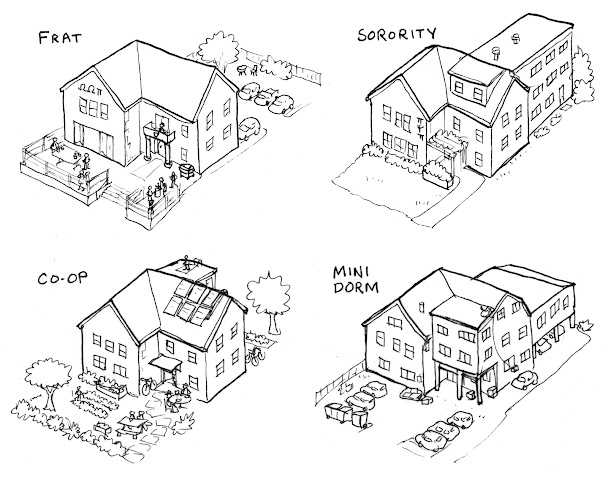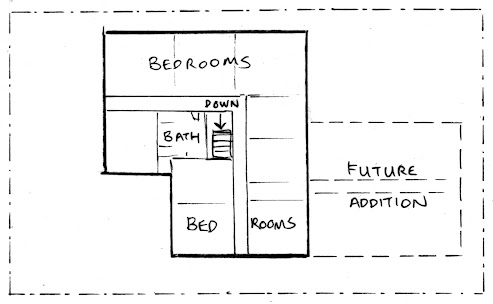Fraternities, Sororities, Co-ops, and Mini-Dorms
Examples shown are smaller buildings located in urban areas. Group living at suburban and rural colleges have larger yards and more parking. The largest sororities are found in the South, and have over 40,000 square feet of indoor space and are located on 1-acre lots.
Time period: Mid/late 1800s to present
Location: College towns
Four types of student group living, separated by gender or economic system
Key features
- Located in clusters close to college campuses
- Shared common spaces and bathrooms
- In addition to residential uses, may also contain study halls and space for parties
From the 1600s to the mid 1800s, college education in the United States was rare, limited to small institutions established by churches to train ministers. Liberal arts education was added in the 1800s. Enrollment was small - a couple dozen to a couple hundred students per college.
In the mid 1800s, as the country grew and started to industrialize, there was a movement to expand higher education as farming, mining, and manufacturing required more advanced skills. However, only a few states did it. When the Civil War started, less than 1% of people in the US had a college education.
With the Southern states seceding, the remaining states were able to pass far-reaching legislation in 1862 that expanded the role of the federal government. This included the Morrill Land Grant Act, which established new colleges and expanded existing ones, with an emphasis on teaching agriculture, engineering, and other practical skills.
This kicked off a rapid expansion of colleges. Colleges would double in size every 10-20 years, and then double in size again. Students needed places to live, and dorm construction didn't always keep up with enrollment increases (sounds familiar?)
At the time, many men in the United States belonged to fraternal organizations, which would have gather for social events and rituals. This tradition also existed in colleges, which also feature honor societies, literary societies and secret societies. With colleges located in small towns far from students' hometowns, getting into the housing business was a natural next step.
Upper floor of a frat. The other types of group living have similar upper floor plans, the main difference is in the lower floors. Bedrooms are a mix of private and shared rooms.
Fraternities
The typical frat house has two functions: it's both a place the brothers - typically 20-50 people - live, and also a place for holding parties. Homebuyers often want a big house for entertaining, and it's possible that this mindset started in college, where regulations pushed most entertaining into residential zones. First, there were laws that banned bars near campus. On top of that, people under 21 could not buy alcohol, but they could live at or go to a party at a frat where an older brother had purchased alcohol.
Frats could be purpose-built or converted from a large house. The frat flips the site plan of a typical house, with the front yard, rather than the back yard, being the primary place for outdoor entertaining. Large decks with room for BBQs and beer pong tables are common. These parties can be extremely loud, and for this reason zoning ordinances limit them to neighborhoods next to campus, in areas known as frat rows.
Most fraternities are part of a national network, with chapters at dozens of colleges around the country. This provides networking opportunities wherever one's career might take them. The houses themselves may be owned by the national organization, the university, or an alumni association.
Sororities
Unlike fraternities, sororities do not hold parties in their houses. This started out due to sexist social norms, but continues today due to insurance costs. Instead, a sorority wanting to hold a party will book a nightclub and charter party buses for attendees to get there. As a result, while the front facade of a sorority looks a lot like a frat - Greek letters and grand entrances - the front yard is very different. It's treated like a standard front yard, neatly landscaped for looking at, with a small front porch.
Sorority first floor and site plan. Residents do not use the kitchen themselves, instead, staff prepares meals.
Sororities also differ from frats in the back, as they are much larger. This is because there are fewer sororities than fraternities, a legacy of sexism during the "golden era" of Greek-letter organizations in the late 1800s and early 1900s, when men outnumbered women in colleges. The reverse is true today, there are now more women in college. Also, sororities have live-in managers. It requires a few dozen people at least to split the cost of the house mom's salary to something reasonable for each member. Most sororities have at least 50 sisters living in the house, larger ones have over 100. As a result, sororities have large dormitory-style wings attached to the back of the house.
At colleges without sororities, there is a myth that sororities are banned by laws that considers a group of women living together to be a brothel. This is just a myth. However, zoning laws written to ban group housing of any gender disproportionately affects sororities. An extreme example was a Boulder, Colorado law that bans more than three unrelated adults from living together. In August 2023, the city council there amended it to a maximum of five unrelated adults. Frats were often established in the era before zoning laws, and allowed to continue as an existing nonconforming use. In contrast, the 1970s, when women's college enrollment increased dramatically, was also the era of anti-housing NIMBY legislation. Finally, while a couple dozen brothers can pack into a large house, the large size of sororities requires additions or a purpose-built building, and land that is zoned for that many people is hard to find.
Like fraternities, sororities are part of national networks, with chapters at multiple colleges.
Co-ops
Student housing co-ops were born out of a need for low-cost housing that was welcoming to those excluded by frats, sororities and private landlords. Originally, frats and sororities had explicit restrictions on membership based on race and
religion. Even today, becoming a member requires going through rush, a
process where existing members select new members.
In contrast, student housing co-ops have an easy application process. New members can apply remotely, and aside from requirements that the resident be a student, there aren't minimum income or credit score screenings. Co-ops started out with separate buildings for men and women, all but a handful went co-ed in the 1970s.
Co-ops are most common at large public universities. To keep costs low, most student housing co-ops are old buildings originally built as something else - including hotels, fraternities, and sororities. Unlike frats and sororities, which are part of national networks, most co-ops are part of a local system, owned by a single nonprofit, with multiple houses around the same college. This creates economies of scale for purchasing food and maintaining the buildings. There is a national organization, NASCO, that promotes knowledge sharing between co-op systems, and also operates and develops new co-ops in places that don't have a local system yet.
Like frats, co-ops also use the front yard like a back yard, but in a different way. Instead of decks for big public parties on football game days, co-op front yards are for everyday hanging out and vegetable gardens. Parties are held indoors.
Rooming Houses / Mini-Dorms
Capitalism's answer to the co-op, rooming houses pop up in college towns wherever there's a shortage of student housing. Early houses were boarding houses which also provided meals, today, due to lower food costs and higher labor costs, houses are room only.
Rooming houses are all about efficiency and profit. The typical one is an old house or former frat near the end of its useful life, with rooms added on. To save money, maintenance is deferred, as students don't know the habitability code, or can't afford to care, preferring a crappy room over living in a car. They have less common space per resident compared to frats, sororities, and co-ops. Instead, first floor common spaces are walled off to create bedrooms. Additional rooms sprout from any facade that wasn't already built up to a yard setback line, with no regard to architectural appearance. Front yards are paved over for parking.

To maximize profits, mini-dorms have minimal amounts of common space, but lots of parking spaces since zoning typically limits the number of bedrooms based on the number of parking spaces available.
Where zoning does not allow additions, a standard 2,000 square foot, 4-bedroom house can still be converted into a 7-bedroom mini-dorm with 10-15 residents, with the living room, dining room, and basement used as bedrooms. With each student paying a few hundred a month or more - a bargain compared to other housing options - that adds up to more than what even a rich family would pay to rent a house.
The lack of common space doesn't mean that rooming house residents don't party. While some houses are leased by the bed to strangers, others have a single lease to a group of friends, members of a college sports team, or an unrecognized or unaffiliated frat. Also known as rogue frats, these are frats that have lost their charter following rules violations, or frats that do not wish to be bound by campus anti-hazing rules in the first place. With absentee landlords and no oversight - often the designated property manager is just a student doing it to get free rent - they can become a neighborhood nuisance.
Many cities have cracked down on rooming houses, banning group housing or passing laws that limit the number of bedrooms that can be added onto a house. Oddly enough, some of the same NIMBYs that oppose mini-dorms also oppose the building of mega-dorms that would absorb student housing demand and prevent it from overflowing into low-density residential neighborhoods.
Data
- Density: 30-150 bedrooms/acre typical. High rise co-ops go up to 300 bedrooms/acre.
- Typical Lot Size: 1/4 acre to 1/2 acre (10,000-20,000 square feet)
- Typical Zoning: Institutional, Low / Medium Density Multifamily
- Construction Type: Varies
- Resident Type: Rental
Where to build
- Within walking distance of colleges
Further Reading
Fraternities
History of drinking age in the USA https://en.wikipedia.org/wiki/U.S._history_of_alcohol_minimum_purchase_age_by_state
History of state legislation banning bars within a mile of UC Berkeley https://www.sfgate.com/food/history/article/claremont-hotel-one-mile-dry-zone-berkeley-15206437.php
Example of city using zoning to go after frats https://fraternallaw.com/wp-content/uploads/2019/03/March-2019.pdf
Overview of zoning impacts on frats and sororities https://www.researchgate.net/publication/228218431_Zoning_for_Off-Campus_Fraternity_and_Sorority_Houses
Sororities
Photos of sororities, with data on number of residents, square footage, etc. https://www.cosmopolitan.com/lifestyle/g19725690/the-40-most-stunning-sorority-houses-in-america/?slide=13
The debate on why sororities can't hold parties https://www.washingtonpost.com/news/wonk/wp/2016/01/22/why-frats-can-throw-parties-but-sororities-cant/
Differences in on-site frat parties vs. off-site sorority parties https://alumni.berkeley.edu/california-magazine/online/greek-expectations-do-frat-partiers-expect-sorority-guests/
Debunking the myth that anti-brothel laws ban sororities https://www.alestlelive.com/opinion/article_666e51be-db35-11e5-b6f1-03411ab35a1d.html
Campaign to allow unrelated people to live together in Boulder, Colorado https://www.bedroomsareforpeople.com/
Boulder raises occupancy limit from 3 to 5 unrelated adults https://boulderbeat.news/2023/08/19/occupancy-limits-raised/
Co-ops
UCLA co-ops, with photo galleries and floorplans https://www.uchaonline.com/
Berkeley Student Cooperative articles of incorporation https://policy.bsc.coop/index.php/Articles_of_Incorporation
Berkeley Student Cooperative history https://ejinjue.org/green-book/
Blog with photos and plans of co-ops, shared houses, and commentary http://itsacoop.blogspot.com
North American Students of Cooperation https://www.nasco.coop/
Rooming Houses / Mini-dorms
The pros and cons of mini-dorms: https://bpr.berkeley.edu/2019/03/13/student-housing-the-rise-and-potential-of-mini-dorms/
Berkeley mini-dorm regulations https://berkeleyca.gov/city-services/livable-neighborhoods/group-living-accommodation-mini-dorm-and-co-op-registry
California court strikes down San Diego mini-dorm ordinance in 2018 https://www.sandiegoreader.com/news/2018/feb/16/ticker-college-area-mini-dorm-litigants-win/
History of student housing at Berkeley https://www.berkeleyside.org/2022/05/08/uc-berkeley-student-housing-building








Comments
Post a Comment